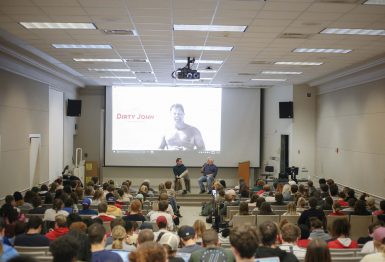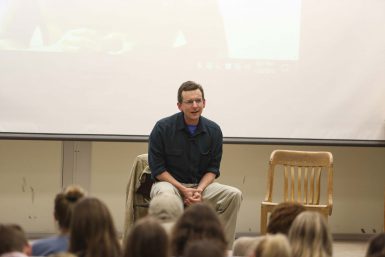Pulitzer winner Goffard explains the power of serialized narratives
Pulitzer Prize-winning reporter Christopher Goffard has written thousands of stories for newspapers. Few have been talked about as much as his recent story, “Dirty John.”
Goffard’s poignant Los Angeles Times series — released in both written and podcast form — depicting domestic abuse and manipulation has been read and listened to by millions of people. Although not everybody in the journalism world does or appreciates serialized narratives, Goffard told students on Monday night that the numbers aren’t wrong.

“If it’s touched this many people, then I think it’s struck a cord, and I think it’s achieved its purpose,” Goffard said.
Goffard is the latest in a string of journalists to talk to professor of practice Tom French’s MSCH-C204: Behind the Prize class, which brings prestigious prize winners or nominees to campus to talk about their work.
Serialized narratives are based on unfolding facts and not summary, Goffard explained to students. It’s about telling stories the way they would be told over a cup of coffee.
“It withholds its secrets for as long as possible. It doesn’t give anything away at the beginning,” he said. “I think that’s why the sort of thing I do is successful and why people keep coming back.”
“Elsewhere in journalism, ‘S-Town’ is a massive success. That’s a serialized narrative,” French explained to his students. “‘Serial’ was a serialized narrative, and if you look beyond journalism in fiction there’s all kinds of proof of the power of this form — from Game of Thrones to Harry Potter and Star Wars.”
Goffard has been a Pulitzer finalist twice and winner once, but his first journalism gig lasted only a few days at his middle school paper. After denouncing the cafeteria and its horrible burritos, he was let go, but he never let go of his skepticism. He covered cops, courts and city hall at the St. Petersburg Times and then went to the Los Angeles Times, where he continues to write about crime.
People today probably live in safer circumstances than any time in human history, Goffard explained. The homicide rate is much lower than it was in The Middle Ages, and murders are rare tragedies, yet people are fascinated with crime.
“I think we believe deep down that our sense of safety is illusory, and I think that maybe through crime (stories) is a way of working through those anxieties,” Goffard said.

As savvy and skeptical as people may think they are, Goffard said he believes everyone has some area of naivete that could be their downfall in the right hands. That’s what happened in Debra Newell’s case in “Dirty John.”
“All of us have weaknesses, and I think this story invites us to think about what our weaknesses might be,” Goffard said.
The type of reporting Goffard does is very intimate. A story like “Dirty John” could take between a few months to a year of reporting. Goffard said he believes it is crucial to build trusting relationships with sources and encourage them it’s in their interest to tell the story.
Crime victims are vulnerable when they choose to share their stories, so it is important for journalists to observe and not place judgment, he said. The Kinsey Institute placard outside Morrison Hall reads, “We are the recorders and reporters of facts — not the judges of the behaviors we describe.”
“That’s a pretty nice summation of my ethos,” Goffard said.
Serialized narratives are not easy journalism, but Goffard said if he is outside his comfort zone and there is a real chance he could disastrously fail, then he is probably doing the right thing. A comfort zone becomes a coffin if you choose to stay in it, he said. Stepping outside your comfort zone could produce some of the most rewarding work.
“If you’re curious about the world, if you want to see the world and get a lot of different experiences, meet a lot of people, ask them the most intimate intrusive questions with absolute impunity, then this is the job for you,” Goffard said. “If you are a curiosity junkie, journalism is the job for you.”
More:

